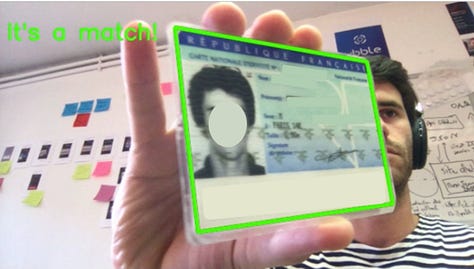What Existed Before ChatGPT? A Discussion with Christophe Lanternier - Ubble
💡 muffin.ai: the media to understand the challenges of AI and leverage them in our society and jobs — by a collective of French engineers & entrepreneurs.
Hello everyone!
Today we are sharing our conversation with Christophe Lanternier, Head of Data at Ubble (acquired by Checkout in 2022).
Ubble is doing remote identity verification through video.
🧁 We loved gaining a better understanding of the evolution of AI research over the past 10 years and specifically addressing discriminative (non-generative) AI.
Thank you Christophe for your insights 👏
On today's menu:
🔦 10 years ago, it was the buzz of non-generative AI!
💡 Advances in non-generative AI
⚙️ What to do with a model without data?
👀 Where to find out - sources recommended by Christophe
If anyone shared this newsletter and you’re willing to subscribe, it’s here:
🧁 MF : Hello Christophe, you who have been in the field for 10 years now, can you comment on the arrival of generative AI in parallel with the older discriminative (non-generative) AI?
👉 Christophe:
Today, there is a lot of talk about generative AI, following the ChatGPT buzz. Indeed, the recent availability of these algorithms opens up a large number of new opportunities, such as the total or partial automation of certain tasks: writing emails, creating creative content, improving the efficiency of operation centers, etc... The applications of this generative AI are just beginning to make their entry into traditional companies (in the non-AI specialized sense), so the value it will bring them is still to be proven.
Non-generative AI, on the other hand, had its buzz about 10 years ago, less spectacularly than ChatGPT, of course, but nevertheless marked the beginning of the era of using data sciences in business. Among the technologies it uses, we can mention machine learning, deep learning, reinforcement learning, generally used for classification purposes (Is there a cat or dog in the picture?) or prediction (what will my sales be at the end of the year?)
This new era was accompanied notably by the appearance of many data science firms, whether within existing companies (GAMMA within BCG, QuantumBlack at McKinsey, Bluestone at EY), or by the creation of new companies (Sicara, Quantmetry, Ekimetrics).
🧁 MF : What are the recent advances in discriminative (non-generative) AI?
👉 Christophe:
There hasn’t been an innovation as groundbreaking as ChatGPT since the revelation of neural networks, but there is an extremely sustained pace of highly relevant innovations, mainly in two directions:
Each application case has its algorithm: Whether you want to run an algorithm in a web browser or on the cloud, whether the input data are ultra HD satellite images, or low-definition facial images, it is increasingly common to find a dedicated algorithm for a given use case (which will, however, most of the time need to be retrained with its own data).
Faster: While the size of the networks (number of parameters) tends to increase, a number of extremely efficient tools allow dividing their calculation time by several orders of magnitude. These tools have become widely democratized in recent years, they are becoming simpler to implement, and more and more efficient. I am thinking in particular of ONNX Runtime, to name the most famous.
However, in business, the problem remains the same, it is not the algorithm itself that will make the difference between a use case that works and a use case that does not work. The key aspects in the success of an AI project remain, in my opinion, the following:
The formulation of the problem from a product point of view (does my algorithm answer the posed problem?)
The quality and quantity of data (is my data well annotated, sufficiently heterogeneous, in sufficiently large quantity?)
The rigor of the development and improvement process of the algorithm (can my code be put into production? Am I able to improve the performance of my algorithm in a reproducible way in a production situation?)
The choice of the algorithm itself will generally only be responsible for a few percentage points of performance (which can have enormous value), and potentially a faster response.
🧁 MF : A question that haunts us, can we work with an untrained artificial intelligence model?
👉 Christophe:
This is the great revolution of algorithms like ChatGPT: for the first time, a single API can be used for a wide variety of problems, without retraining, with unprecedented performance.
But if we go back to more traditional algorithms, as explained earlier, it is increasingly common to find an algorithm that responds well to the context of the problem posed. You would have to be very lucky (it has never personally happened to me) for the performances to be good without retraining the algorithm on your own data.
Generally, the approach is as follows: we specify the problem, find a suitable algorithm, choose the data, train the algorithm, and see what it gives.
However, what about in the absence of data?
We have two choices:
We can use an algorithm trained on roughly similar data. In some use cases common to many companies (for example, face detection), this can give very satisfactory results.
Use a model dating from before the revolution of learning models, namely before the 2000s. The charm of the old!
While this may seem retrograde, keep in mind that task automation has always been an important field for scientific research, and it has happened that before the 2000s, some non-learning algorithms were of formidable efficiency and can still today compete with their modern counterparts in terms of accuracy and robustness. The fact that these algorithms were developed at a time when the available computing power was much lower than today also makes them much faster and economical.
To take a very concrete example, this is exactly what happened to us at the beginning of Ubble. We were looking for an algorithm that would allow us to "crop" (precisely cut out any identity document in an image and flatten it, see images below), any identity document, in any lighting conditions and resolution, all in real time (meaning less than 150 ms of calculation per image).
The problem: there was no (at the time) pre-trained algorithm specialized in this task, and even less a public database of identity documents (and for good reason).
So we turned to a technology dating from the 90s, which we adapted to our use case, and which ultimately perfectly answered the problem. So much so that it has been running in production for several years.



🧁 MF : Thank you, Christophe! Can you leave us with the sources you recommend for delving deeper into the topic?
👉 Christophe:
Two excellent podcasts, made in France:
Data driven 101 by Marc Sanselme, an AI & Data podcast. It offers many very concrete and relevant examples of AI applications in business.
DataGen by Robin Conquet, more focused on the Data Analytics part. This podcast got me started in understanding the data analytics ecosystem when I took up my position as head of data.
A book I read recently:
Toxic Data by David Chavalarias: “how networks manipulate our opinions”. It's a bit frightening but very enlightening on the exploitation of data by social networks, and the threat it poses to our democracies.
Enjoy your week !
— muffin.ai team
If you enjoyed the edition, consider clicking on the ❤️ button and leaving a comment so that more people can discover muffin.ai on Substack 🙏




